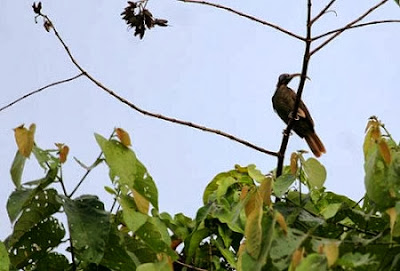 |
| Male Pale-billed Sicklebill |
The Pale-billed Sicklebill is
a medium sized bird of paradise. Its scientific name is Drepanornis bruijnii,
Drepanomis is a Greek word which means sickle bird, Bruijnii named after Dutch
Plume Trade dealer (Antonie Augustus Bruijn). As its common name describes pale
bill which makes it prominent from other species of sicklebill. The adult male
is approximately 35 cm in length, while adult female is about 34 cm long.
Male Pale billed sicklebill is olive brown bird
of paradise. Male has black head with naked blue face patch and purple
iridescent feathers below eye, brown arc,
pale sicklebill, pectoral
feathers tipped with iridescent green, longer pectoral plumes tipped purple,
smaller ones bronze and remaining underparts lavender grey and tail russet. The
adult female
is unadorned and has same upperparts
as male but little paler and more buffy and less iridescence, from downside it
is buffy and pale cinnamon with dark brown stripes. Both have
long and pale curved beaks. |
| Pale-billed Sicklebill Eating Berries |
Behaviour:
The Pale-billed
Sicklebill is polygynous. This species is sexually dimorphic. Their display
recorded in August. Solitary male shows from tradional sites and visits its
territory on daily basis for counter display to its competitors. They are less
known for their courtship display other than male adopts static posture, fans
pectoral, flank feathers and tail with mouth agape. Pale-billed sicklebill
feeds mostly on fruits and arthropods.
 |
| Pale-billed Sicklebill on Tree Branch |
Range & Threats:
The Pale-billed
Sicklebill is spread out to lowland rainforests of northwestern New Guinea (0-180m), Eastern Geelvink
Bay east through Meervlakte probably Idenburg Basin and north coastal
lowlands to Vanimo area and north western reaches of Sepik River drainage. Due
to deforestation and habitat lost on this limited range species, the
Pale-billed Sicklebill is estimated as near threatened on the International Union for Conservation Nature
Red List of Threatened Species.
It is listed on Appendix II of Convention on International Trade in Endangered
Species.
No comments:
Post a Comment